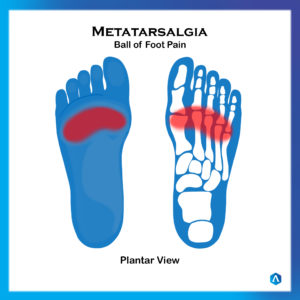Metatarsalgia (ball of foot pain)
- Edgard Diaz
- July 8, 2019

This is a common ailment and mainly located under the 2nd, 3rd and 4th metatarsal heads, or isolated at the first metatarsal head (near the big toe). It can sometimes be diagnosed as Morton’s Neuroma, but this has more localised pain than metatarsalgia.
Although not considered a serious condition, metatarsalgia can put you out of action and affect quality of life.
Causes are many, such as excessive pronation due to foot type and imbalanced biomechanics, when soft tissue structures weaken and muscle wastage can occur. Also poor fitting shoes, excessive weight, intense physical activity and foot deformities can be the cause. It is also related to frictional shearing forces on the metatarsal heads or ball of foot due to constant elongation on the foot. The patient not only loses the longitudinal arch but also the transverse arch.
Symptoms
The key symptom is pain in the ball of the foot – this can vary from being a burning sensation to sharp stabbing pains and tingling in your toes. Usually the pain will increase when you stand, run, walk or flex your foot in anyway – particularly if walking on man made, hard ground. Some may also feel like they constantly have a stone in their shoe.
Assessment
To confirm metatarsalgia it is important to get a full biomechanical assessment and treatment program set up. If left untreated the condition can become severely debilitating.
Treatment
Rest to protect from further injury is the first thing to do and using ice packs at home. Treatment can also include orthotics, metatarsal pads and footwear changes, plus anti-inflammatory medication.
- Footwear – changes can help stabilise the foot and keep it balanced for everyday activities and make sure the base of the shoes is not thin. Avoiding high heels is a must as these destabilise the foot.
- Orthotics – are corrective, medically prescribed innersoles, designed to support, control and align the foot whilst correcting mechanical issues from the feet up, treating the cause.Use of orthotic therapy is an excellent regime as it helps realign the body’s biomechanical structure and control any excess foot pronation, eliminating the pull that occurs at the insertion point. They also help stabilise the foot and the growth plate to decrease inflammation and pain.
- Massage – even though many practitioners recommend stretches for the plantar fascia, at Dr Abbie Clinics we believe the cause can sometimes be over stretching of the plantar fascia, so plantar fascia massage is recommended
- Dry needling – soft tissue (muscles, tendons, ligaments) can often demonstrate taut bands of tissue – commonly known as trigger points, scar tissue or adhesion areas. This can adversely affect range and quality of motion around joints and muscle ultimately leading to pain and discomfort. An acupuncture needle inserted in and around these taut bands of tissue can instigate a muscle twitch response. The body identifies the needle as a ‘foreign object’ which then will elicit an inflammatory response to the area subsequently breaking down the scar tissue.
- Foot mobilisation and adjustments – helps re-align the bones of the foot to reduce the stress on the plantar fascia.
- Anti-inflammatories – can reduce any inflammation caused by the spur and corticosteroid injections for severe cases are another approach.
If you are experiencing these symptoms call 1800 DR ABBIE or email reception@dr-abbie.com to organise an assessment.


